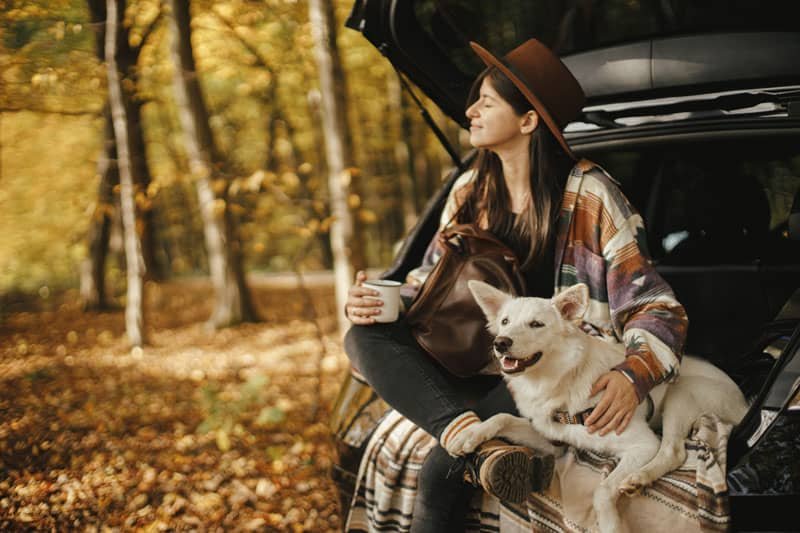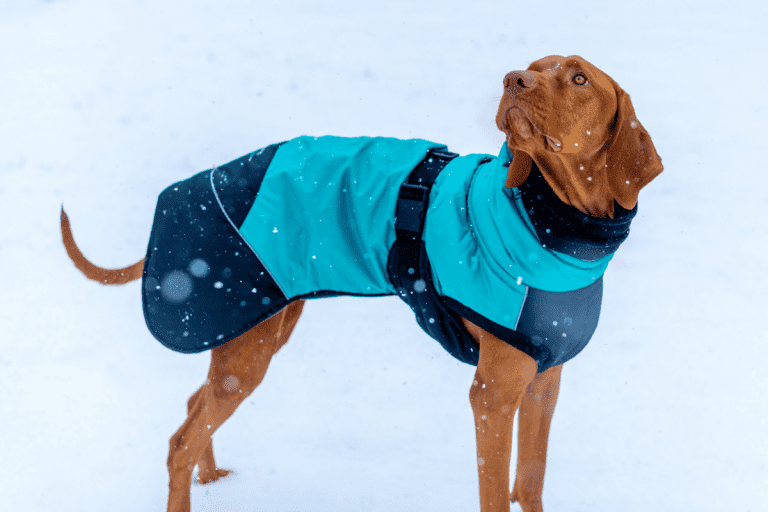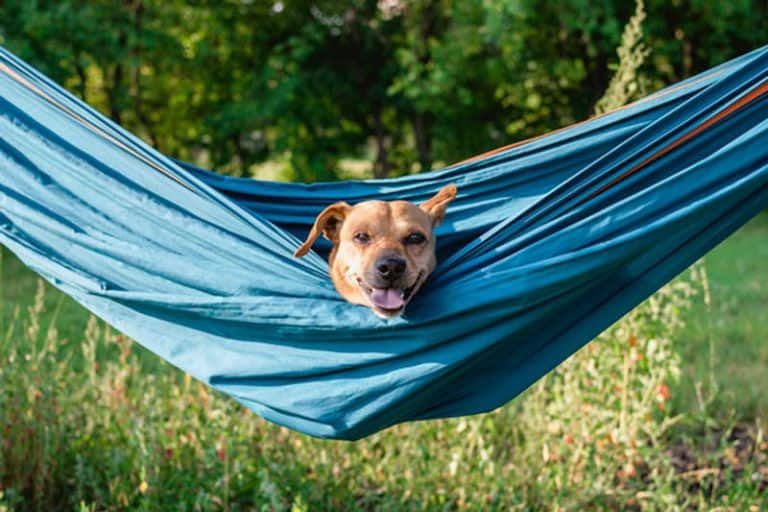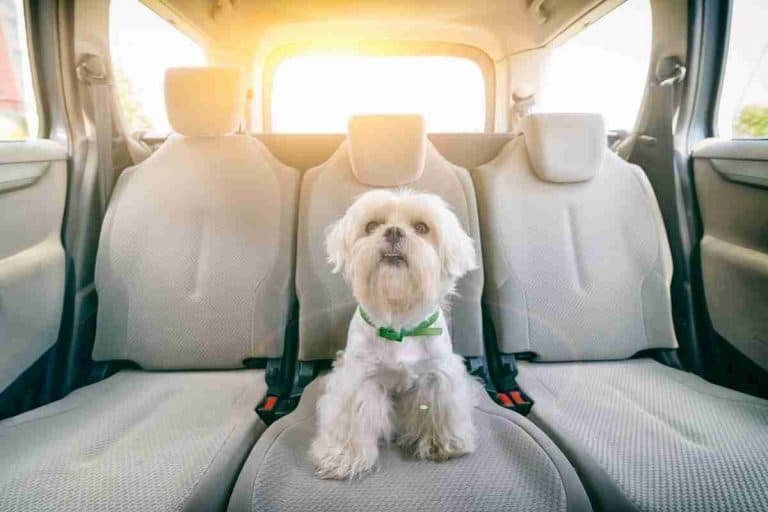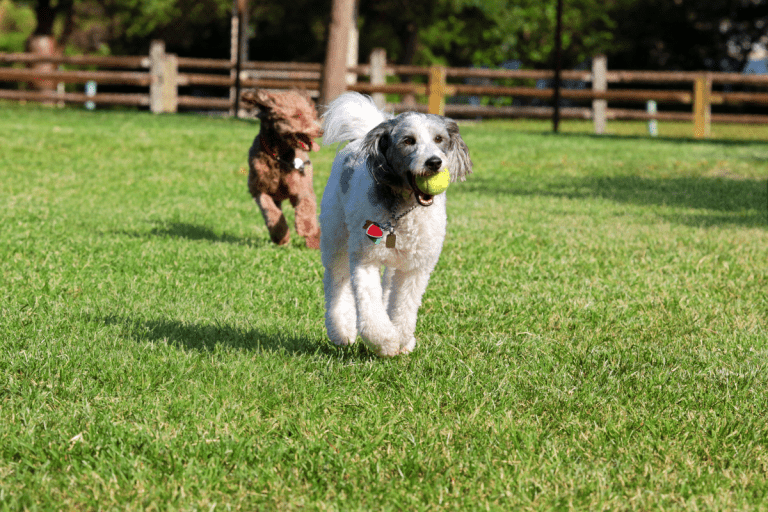9 Natural Ways to Remedy Your Dog’s Travel Anxiety: Vet‑Approved, Practical Tips
Affiliate Disclaimer: As an affiliate, we may earn a small commission when you make a purchase from any of the links on this page at no additional cost to you!
Last Updated on October 16, 2025
Many dogs panic as trips begin. Owners notice whining, drooling, trembling, pacing, and escape attempts tied to travel cues. This vet‑approved guide shares natural, practical ways to remedy a dog’s travel anxiety. The aim is simple: safer, calmer rides by making cars, planes, and trains feel predictable.
Readers will learn to spot true travel anxiety and rule out motion sickness or noise sensitivity. They’ll see when urgent veterinary care is necessary. Then they can apply nine proven strategies—desensitization rides, a comforting crate setup, compression wraps, pheromones, calming music or white noise, timed exercise, vetted supplements, soothing touch, and food puzzles. A step‑by‑step training plan, packing checklists, safe restraint options, and supplement guidance round out the approach. Continue for clear, vet‑guided steps to make the next journey easier.
How to tell travel anxiety from other travel problems
Travel anxiety usually appears as a cluster of predictable behaviors tied to travel events. Owners should look for repeated patterns that start when packing, when approaching a vehicle, or as a plane or train ride begins. Signs that point toward anxiety rather than another problem include consistent vocalizing, trembling, pacing, attempts to escape, and elimination only during travel episodes. Physical stress signs such as drooling, panting, and restlessness often accompany those behaviors.
Context and timing help rule out other causes. If the dog acts fine at home but reacts only during motion or loud noises, anxiety ranks high. If signs appear suddenly during travel after medical stability, consider injury, inner-ear disease, or vestibular issues. Keeping a short video log of episodes helps a veterinarian make an accurate assessment.
For practical travel preparation and to reduce confusion about causes, consult resources on essential dog travel tips and gear for road trips. When doubt remains, owners should schedule a veterinary exam to exclude medical causes before starting behavior work or natural remedies.
Common behavioral and physical signs to watch for
Behavioral signs tend to be consistent across anxious dogs. Watch for whining, continuous barking, trembling, excessive licking, freezing, and frantic attempts to escape a carrier or vehicle. Some dogs refuse to enter cars or crate before a trip.
Physical signs often occur alongside behaviors. These include heavy panting without exercise, drooling, trembling, pacing, diarrhea, and vomiting. Repeated gastrointestinal upset only during travel suggests stress-related GI effects rather than a food allergy.
Document frequency, intensity, and triggers. Owners should note whether signs start during packing, at departure, during motion, at loud noises, or at checkpoints. A useful comparison appears in reports about why dogs react in cars; the post on why dogs cry in the car offers concrete examples of stress-driven vocalization versus pain signals.
Motion sickness vs fear vs noise sensitivity — how to differentiate
Different causes produce distinct clusters of signs. Motion sickness produces drooling, lip smacking, yawning, nausea, vomiting, and lethargy early in a ride. The dog might appear disoriented or unwilling to eat before travel.
Fear produces hypervigilant body language: wide eyes, pinned ears, fixed attention on exits, trembling, and escape attempts. Fear often escalates when owners show anxious cues or when a specific context repeats, such as entering an airport.
Noise sensitivity triggers sudden startle responses, hiding, covering the ears, and freezing only when particular sounds occur. Dogs sensitive to thunder, sirens, or aircraft noise may be calm otherwise.
Short, controlled tests help separate causes: a quiet, short stationary acclimation session can reveal fear or noise sensitivity. A brief motion-only exposure identifies motion sickness. For motion-sickness-specific management, see tips in No More Doggie Dramas: How to Make Car Rides Enjoyable for Your Motion-Sick Pup.
When anxiety becomes an emergency or needs veterinary attention
Some travel reactions require immediate veterinary care. Seek urgent attention for collapse, seizures, severe difficulty breathing, continuous non-stop vomiting, or obvious injury from escape attempts. Prolonged hyperventilation or pale gums indicate a medical crisis.
Other signs merit prompt veterinary evaluation but not emergency transfer. These include persistent vomiting causing dehydration, sudden head tilt or balance loss (possible vestibular disease), bloody diarrhea, or ear pain with head shaking. Ear barotrauma during flights can present as severe head shaking, ear discharge, or abrupt behavioral change; owners should treat such signs seriously. See guidance on ear pressure and travel in Does flying hurt dogs’ ears?.
When behaviors interfere with safe travel, a veterinarian can rule out medical issues and discuss short-term medical options. If immediate danger exists, owners must seek emergency care. For non-emergent anxiety, a behavior plan with gradual desensitization and veterinarian-approved supplements or medications can follow after medical clearance.
9 natural ways to calm your dog during trips
Travel anxiety can show as whining, pacing, drooling, or trying to escape. Each natural strategy below focuses on predictable, low-risk methods owners can use to ease stress on short drives or longer journeys. Combine multiple approaches and track which ones reduce signs of panic. For practical packing and preparation tips that pair well with these methods, see essential dog travel tips and gear for road trips.
Gradual desensitization and short practice rides
Gradual desensitization means slowly increasing exposure to the travel experience. Start with a few minutes of sitting in a parked car, rewarding calm behavior with soft praise and tiny treats. Progress to short drives around the block, then to longer routes. Keep sessions brief and end before the dog shows strong stress signals. Repeat daily, keeping each ride predictable. For ideas on reducing motion-related distress and making rides enjoyable, consult the tips in how to make car rides enjoyable for your motion-sick pup.
Build a comforting travel zone (crate, bedding, familiar scents)
Design a consistent travel space so the dog recognizes safety. Use a well‑ventilated crate, a non‑slipping bed, and a favorite blanket or toy. Spray or rub the bedding with a familiar home scent ahead of travel. Secure the crate to prevent movement; stabilization reduces fear. Inspect crates for size and airflow, and choose models tested for car use. For crate options and reviews tailored to road travel, see best dog crates for car travel.
Use gentle pressure (Thundershirt or compression wrap)
Gentle, consistent pressure can lower arousal. A Thundershirt or compression wrap applies light, reassuring pressure around the torso. Fit it at home first, and pair with calm treats so the dog forms a positive association. Do not overtighten; the garment should allow normal breathing and movement. Observe for signs of overheating on long trips. For safe ways to secure a dog and their gear during travel, owners can review practical restraint methods at how to secure a dog in car with leash.
Try pheromones, calming sprays or collars
Pheromone diffusers and collars release dog-appeasing chemical signals that can reduce stress in many dogs. Calming sprays with synthetic pheromones work on bedding and crate interiors. Collars deliver continuous exposure and can help during multi-hour trips. Monitor the dog for skin irritation and effectiveness; results vary between individuals. For additional advice on managing vocal distress and calming strategies during travel, consult resources such as dog whining on plane.
Play calming music or white noise specifically for dogs
Sound influences arousal. Play playlists engineered for canine relaxation or steady white noise to mask outside sounds. Keep volume low and test at home first. Rhythmic, slow-tempo classical pieces or ambient tracks can reduce barking and pacing. Avoid sudden loud noises and abrupt track changes. Owners who want to understand behavioral cues and why dogs vocalize en route can read more at why dogs cry in the car.
Exercise and tire your dog before travel
A well‑timed energy outlet lowers reactive behavior. Offer a vigorous walk, play session, or short run one to two hours before departure. Tailor intensity to the dog’s age and health. Exercise reduces excess adrenaline and promotes calm during the trip. Bring water, and avoid heavy feeding immediately before travel to reduce nausea. For practical dog activity and outdoor travel tips that complement pre-trip exercise, review suggestions in 9 tips for hammock camping with your dog.
Offer natural supplements and herbal options (vet consult first)
Several natural supplements may ease travel anxiety, including L‑theanine, melatonin, and certain herbal blends. Proprietary supplements formulated for pets often combine these ingredients. Always consult a veterinarian before administering any supplement. Dosage, interactions, and underlying medical issues matter. Bring vet guidance and product labels when traveling. For insight into managing vocal incidents and what airlines or carriers may consider, see guidance at what happens if my dog barks on a plane. CTA: confirm any supplement with the dog’s veterinarian before use.
Use massage, calming touch and predictable cues during the trip
Calm, rhythmic massage reduces heart rate and anchors attention. Gentle strokes along the neck and shoulders or slow circular motions over the chest help many dogs. Pair touch with soft, predictable verbal cues like “relax” or “easy.” Maintain a steady speaking tone and avoid sudden movements. Establishing a short pre‑departure routine signals what comes next and lowers uncertainty. For broader travel setups and steady routines in mobile environments, review practical stability tips at 6 ways to secure a dog in 2-berth motorhome.
Provide distraction with treats, chew toys and puzzle feeders
Distractions occupy attention and lower stress. Use long‑lasting chews, safe puzzle feeders, or lick mats loaded with frozen treats to lengthen calm periods. Rotate toys to maintain novelty. Offer small, frequent rewards during short practice rides to reinforce calm behavior. Supervise to prevent choking or ingestion of unsafe items. For travel-specific ideas on keeping pets occupied and comfortable on public transport, see traveling with your dog by train tips and tricks.
Step-by-step training plan to prepare your dog for travel
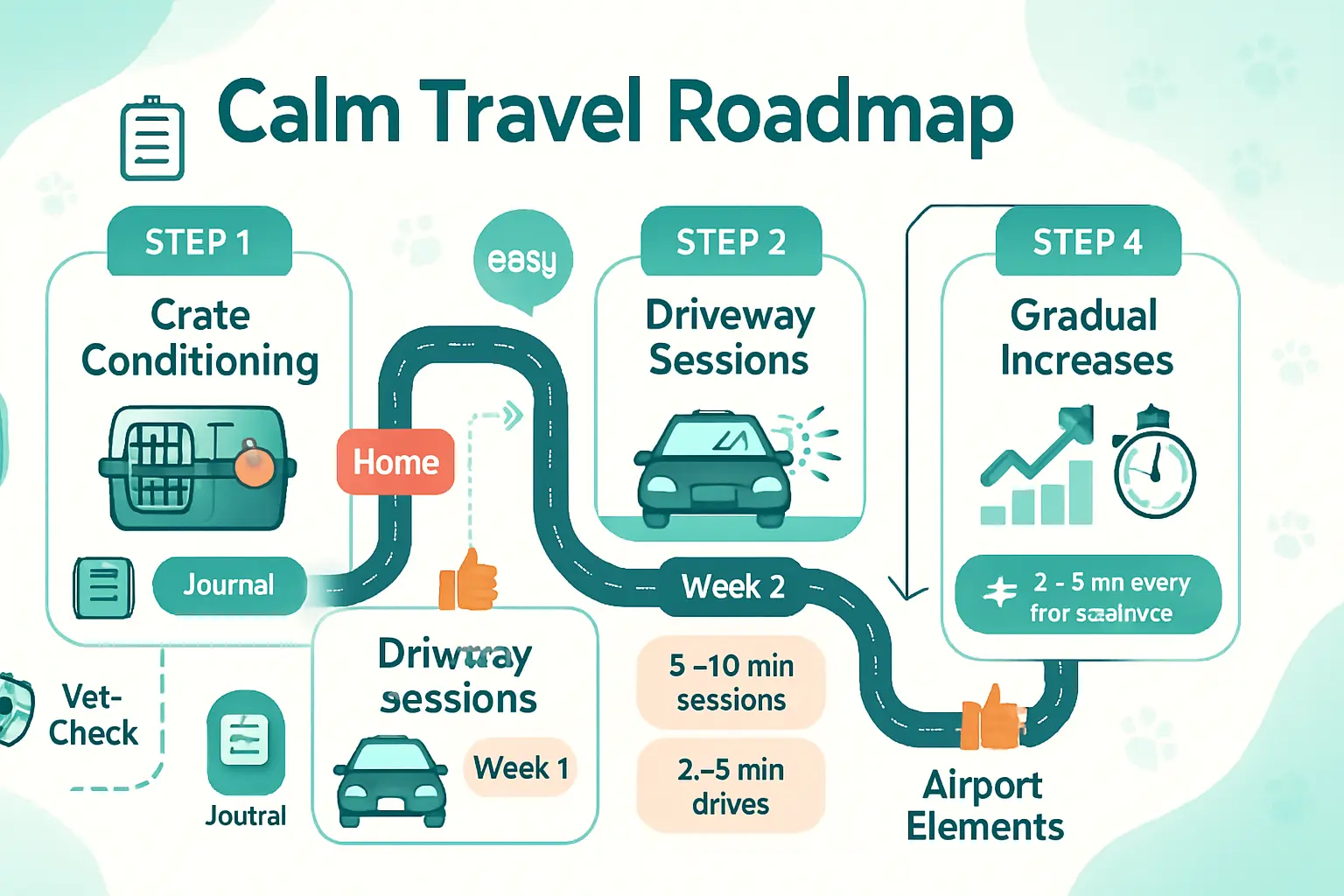
Prepare a clear, staged plan that builds confidence and reduces travel anxiety. Start with short, predictable sessions and increase intensity only when the dog shows calm behavior. Break training into daily micro-sessions of five to ten minutes. Use consistent cues, a quiet voice, and the same gear the dog will use during travel.
Begin with carrier or crate conditioning, then add short car sits, short drives, and finally longer trips and airport-like environments. Track progress in a simple journal: note duration, behaviors, and calming signals. Adjust pacing if the dog shows avoidance or stress.
Include vet input for health checks and rule out motion illness before increasing exposure. For practical equipment and packing tips that support training and comfort, consult essential dog travel tips and gear for road trips. A trained professional or certified behaviorist can refine the plan for severe anxiety. Encourage owners to reward small wins and remain patient; consistency over weeks yields the best results. For a gentle CTA: consider scheduling one brief session today, then build from that success.
Conditioning the carrier or crate at home
Make the carrier or crate a predictable, inviting space. Start by placing it in a common area with the door open. Scatter high-value treats and familiar toys just inside. Allow the dog to enter voluntarily. Use short sessions multiple times per day and slowly increase time spent inside.
Pair the crate with pleasant activities like mealtime and chew toys. Feed complete meals inside the crate for several days to form a positive association. Gradually close the door for a few seconds, then open it and reward calm behavior. Increase closure time only when the dog remains relaxed.
Use soft bedding and an item with the owner’s scent to reduce separation stress. If a crate will travel in the car, practice placing it in the vehicle while stationary, then reward calmness. For guidance on choosing travel-friendly containment, see this review of the best dog crates for car travel. Always avoid forcing the dog into the crate; allow voluntary entry and reward each step.
A progressive exposure schedule for cars and airports
Organize exposures in measurable steps and use objective criteria for progression. Week 1: car sits and engine-on sessions in the driveway. Reward calm behavior and end sessions before stress appears. Week 2: short drives of 2–5 minutes, returning home and rewarding calm. Gradually increase drive length by 2–5 minutes every few sessions.
Introduce airport elements after consistent success in cars. Begin with recordings of terminal noise while at home. Next, visit an airport parking lot; sit in the parked car and reward relaxation. Progress to a short walk through a quiet terminal or observation area if the airport allows pets. Focus on desensitizing sounds, moving crowds, and luggage trolleys.
Monitor body language for yawning, lip-licking, pacing, or panting as signs of stress. If stress rises, step back one level and repeat until the dog stays calm. For tips on managing vocal reactions in travel settings, review what happens if my dog barks on a plane. Keep pacing slow; successful habituation often takes weeks, not days.
Counterconditioning techniques that pair travel with rewards
Counterconditioning replaces a negative travel response with a positive one by pairing travel cues with high-value rewards. Identify travel cues: carrier open, leash click, car door. Immediately follow each cue with a preferred reward, like freeze-dried meat, a favorite chew, or a stuffed toy. Use rewards only during training, not at other times, to preserve their potency.
Combine counterconditioning with a predictable pre-travel routine: brief play, then a calm treat, then the carrier cue. Use a clicker or marker word to mark the exact moment the dog accepts a cue calmly. Gradually increase the cue’s intensity while delivering rewards for calm responses.
For dogs who refuse car entry, pair the first step—paw on ramp or threshold—with an irresistible reward and praise. For more ideas on overcoming entry refusal, consult dog refusing to get into car. Track rewards, reduce frequency as the dog learns, and replace food with praise and short play over time to maintain the new association.
Practical pre-trip and on-the-road preparations
Vet check, motion-sickness prevention and paperwork to arrange
A pre-trip vet visit gives a clear baseline for behavior and health. The veterinarian can screen for anxiety, rule out medical causes, and recommend safe interventions. Ask about motion-sickness options, such as anti-nausea medications or natural supplements. Try any medication or supplement at home first to watch for side effects. Gather paperwork early: vaccination records, a health certificate if required, and proof of microchip registration. Store digital and printed copies.
For motion sickness, owners should combine short practice drives with gradual exposure. Conditioning reduces stress and lowers reliance on meds. For step-by-step tips on making short drives less stressful, refer to make car rides enjoyable for your motion‑sick pup. Book veterinary or animal control contacts at your destination and along the route. If the vet prescribes a sedative, confirm dosing and transport restrictions. Keep all authorizations accessible, especially for cross-border travel. Proper paperwork and a vet plan reduce last-minute anxiety for both dog and caregiver.
Meal, hydration and medication timing before departure
Timing food, water and meds helps prevent nausea and accidents. Feed a light meal three to four hours before leaving for car trips. Smaller, familiar snacks work better for anxious dogs. Offer water up to one hour before departure, then provide small sips during stops rather than a continuous bowl in the vehicle.
Follow medication schedules exactly. If a vet prescribes an anxiolytic or antiemetic, record times and amounts. Use reminders on a phone or a physical chart. For multi-day road trips, pack measured doses in labeled containers and keep a copy of prescriptions.
Owners should trial the planned schedule at home or on short drives to observe appetite and hydration responses. Avoid abrupt diet changes, which can increase gastrointestinal upset. For broader gear and packing advice that supports feeding and comfort on long journeys, see essential dog travel tips and gear for road trips. Proper timing reduces motion sickness and keeps the dog calm and hydrated.
Route planning, scheduled breaks and safe bathroom stops
Effective route planning balances driving time with frequent, predictable breaks. Map stops every one to two hours for short walks, sniffing, and toilet breaks. Predictability lowers a dog’s stress by creating a routine. Choose stops with shaded areas, secure leashes, and low foot traffic whenever possible.
Plan for local regulations and facility types. Rest areas and pet-friendly parks work well. For air or rail segments, confirm onboard restroom policies and pre-boarding options. When planning bathroom stops for travel across modes, consult resources that explain canine bathroom considerations during transit, such as how dogs go to the bathroom on a plane, and adapt those timing principles to road travel.
During stops, keep introductions short and positive. Use a harness and a secure leash. Offer a brief walk to burn nervous energy, then a calm return to the vehicle. Maintain a consistent stop schedule to build the dog’s confidence on the road.
Travel checklist: ID, first-aid, favorite items and emergency contacts
Create a concise, portable travel checklist and attach it to the main travel bag. Include: current ID tags, microchip number and registry info, vaccination records, and medication list with dosages. Pack a small first-aid kit with bandages, antiseptic wipes, tweezers, and a copy of the vet’s emergency instructions.
Comfort items lower anxiety quickly. Add a favorite blanket, a worn t-shirt with the caregiver’s scent, and a couple of familiar toys. Keep food measured in resealable containers and bring a collapsible water bowl for quick hydration. Store emergency contacts in multiple places: phone, printed card, and email. Add local emergency clinics along the route.
Secure travel gear before departure. For crate users, ensure the crate attaches reliably in the vehicle; find practical methods in 5 ways to secure a dog crate in car. Print or screenshot the checklist and save it to the phone. A prepared checklist reduces on-road stress and speeds response during unexpected events. CTA: Save or print the checklist before the trip begins.
How to create a calming travel environment in the vehicle
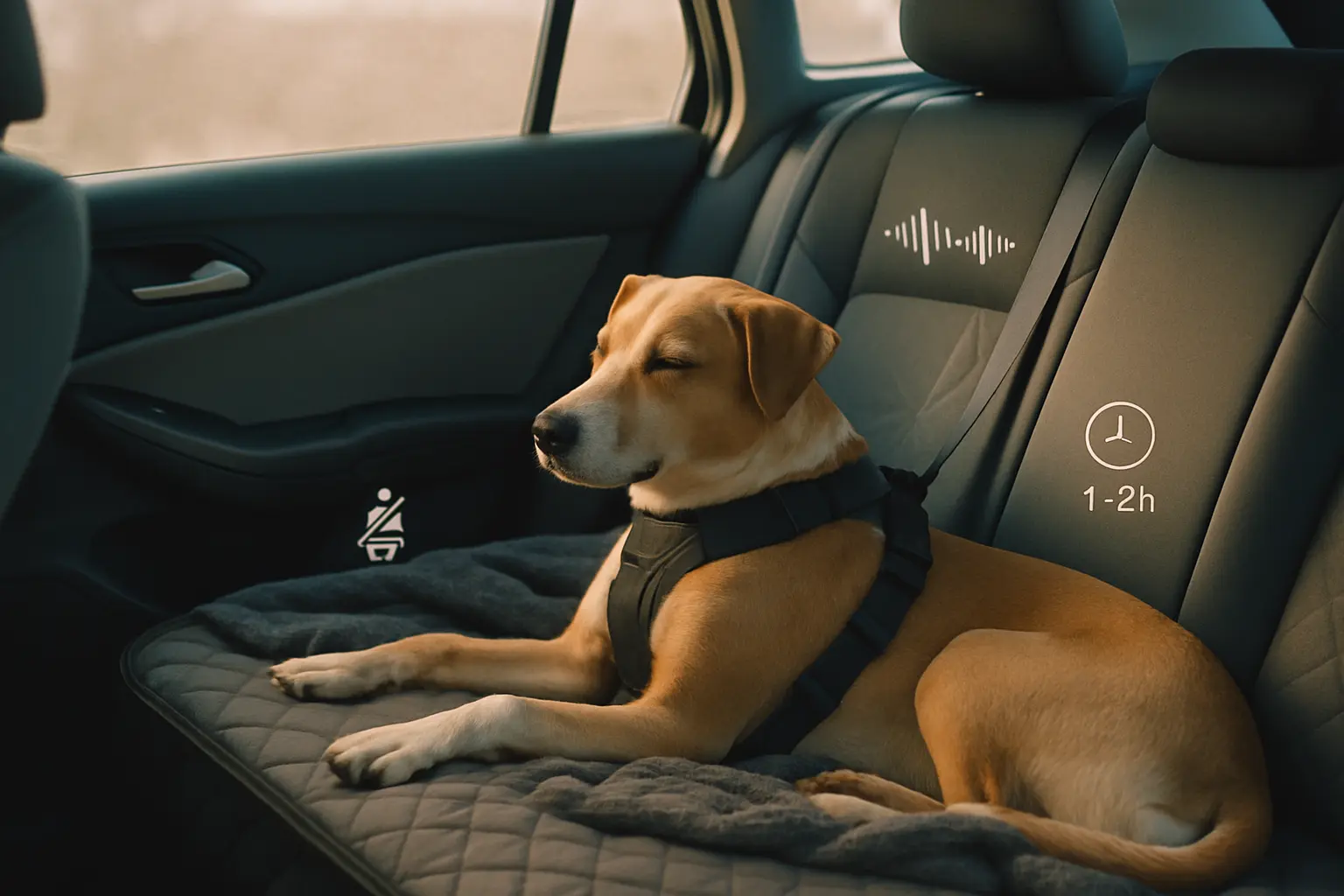
The goal of a calming travel environment is to reduce stressors and give the dog predictable cues. Start by selecting a dedicated travel spot the dog uses consistently. A steady routine—loading cue, short pre-ride play, and a calm voice—helps the animal anticipate the trip. Keep the cabin quiet; low-volume music or a steady white-noise playlist soothes many dogs. Avoid loud radio or sudden sound changes that trigger alertness. Use low lighting for early-morning or evening drives to lower arousal.
Owners should check that the space allows stable footing and minimal sway. Block sudden drafts and direct sun with sunshades or window tinting to prevent overheating. For step-by-step gear and prep guidance, consult essential dog travel tips and gear for road trips.
Introduce travel gradually: short trips, then longer ones, rewarding calm behavior with treats and brief breaks. If stress remains high despite environment changes, the next sections cover restraint, bedding, and visual management to refine the setup.
Safe restraint options: crates, harnesses and seat‑belt systems
Safety and comfort go hand in hand. Choose a restraint that fits the dog’s size and mobility. Crates provide a den-like refuge and reduce motion-related injury. Select a crate rated for car travel and secure it to the vehicle frame or cargo area to prevent sliding. For those who prefer harnesses, use crash-tested, vehicle-specific harnesses that attach to the seat‑belt or anchor point. Avoid simple leash-only attachments; they can cause injury during sudden stops.
Measure chest girth and length before purchase and follow manufacturer fit guides. If a crate is used, add non-slip matting and fasten with straps or a cargo barrier. For small dogs, carriers that clip into seat belts work well when rated for automotive use. Install and test restraints at home before travel. Practice short, secured sessions so the dog learns that restraint equals safety, not punishment.
For a guide to crate types and car-securement methods, reference the best dog crates for car travel in 2023: a comprehensive review. A vet or qualified trainer can recommend specific models for breeds with respiratory or orthopedic issues.
Bedding, familiar scents and temperature/ventilation tips
Comfortable bedding reduces anxiety by providing predictable texture and scent. Use the dog’s favorite blanket or a worn T‑shirt from the household to add familiar smells. Opt for breathable fabrics and low-profile cushioning to avoid overheating. Choose washable, non-skid pads that fit the restraint and won’t bunch during turns.
Maintain steady airflow without blasting cold air directly onto the dog’s face. Open vents, window deflectors, or rear-seat fans can circulate air while preventing drafts. Keep interior temperature moderate; dogs overheat quickly. Use sunshades on side windows and park in the shade during stops. Never leave a dog unattended in a parked vehicle.
For scent-based calming, use vet-recommended products or a cloth with household scents rather than concentrated essential oils. Small chew toys or lick mats filled with a safe, travel-only treat also distract and soothe. For more tips on making rides pleasant for sensitive dogs, see make car rides enjoyable for motion-sick pups. Experiment with one change at a time to identify the most effective combination.
Manage visual stimulation: window access, covers and sightlines
Visual input influences arousal and motion sickness. Some dogs calm when they see familiar scenery. Others escalate when road activity becomes a constant trigger. Assess the dog’s reaction to window access before assuming it helps. If the dog paws or strains toward windows, reduce visual stimulation by limiting direct view.
Use partial covers on crates or carriers to create a den-like feel while keeping ventilation. A breathable cover that blocks motion in the peripheral sightline helps anxious dogs settle. Position the crate or harness so the dog faces forward when possible; many dogs handle motion better when facing the direction of travel.
Gradual desensitization works: start with short rides where the dog sees little movement, then slowly increase exposure. If the dog cries or fixates, try switching to a covered crate or a rear-seat barrier that reduces side-window views. For behavior clues and troubleshooting, consult the piece on why dogs cry in the car. Small, systematic changes to sightlines often yield the biggest reductions in travel anxiety.
Responsible use of natural supplements and remedies
Natural options can ease a dog’s travel anxiety, but owners must handle them responsibly. Supplements vary in strength, onset and evidence. Owners should treat them like medications. A veterinarian helps match a product to a dog’s medical history, current medications and travel plan. For practical travel preparations and containment strategies that pair well with calming aids, owners can review essential dog travel tips and gear for road trips.
Why you must consult your veterinarian first
A veterinarian rules out medical causes of anxiety and identifies contraindications. Some remedies worsen conditions or interact with prescription drugs. Pregnant dogs, puppies and dogs with liver, kidney or endocrine disease need tailored advice. The vet can recommend diagnostics, appropriate products and monitoring steps. Bringing product labels to the appointment improves guidance.
Common options explained: chamomile, L‑theanine, melatonin, CBD, Rescue Remedy
Chamomile offers mild calming and can reduce gastrointestinal upset. L‑theanine promotes relaxation by supporting GABA pathways and often pairs with other nutraceuticals. Melatonin helps dogs with situational anxiety and sleep-related stress. CBD may reduce anxiety for some dogs but varies by product quality and dose. Rescue Remedy (Bach flower mix) provides a gentle option with minimal side effects, though clinical evidence is limited. Choose veterinary-formulated products with clear ingredient lists and third‑party testing when available.
How to trial, dose safely and watch for interactions or side effects
Introduce one product at a time and trial it at home before travel. Start at the lowest labeled dose and monitor behavior, appetite and coordination for 24–72 hours. Keep a log of effects and side effects. Watch for excessive sedation, gastrointestinal signs, paradoxical agitation or changes in respiration. Avoid combining sedatives, MAOIs or other psychoactive drugs without veterinary approval. If any worrying sign appears, stop the product and contact the veterinarian. Schedule a follow-up to adjust the plan before the next trip.
CTA: Owners should consult the veterinarian to create a safe, documented plan before using any supplement during travel.
When to seek professional help or consider medication
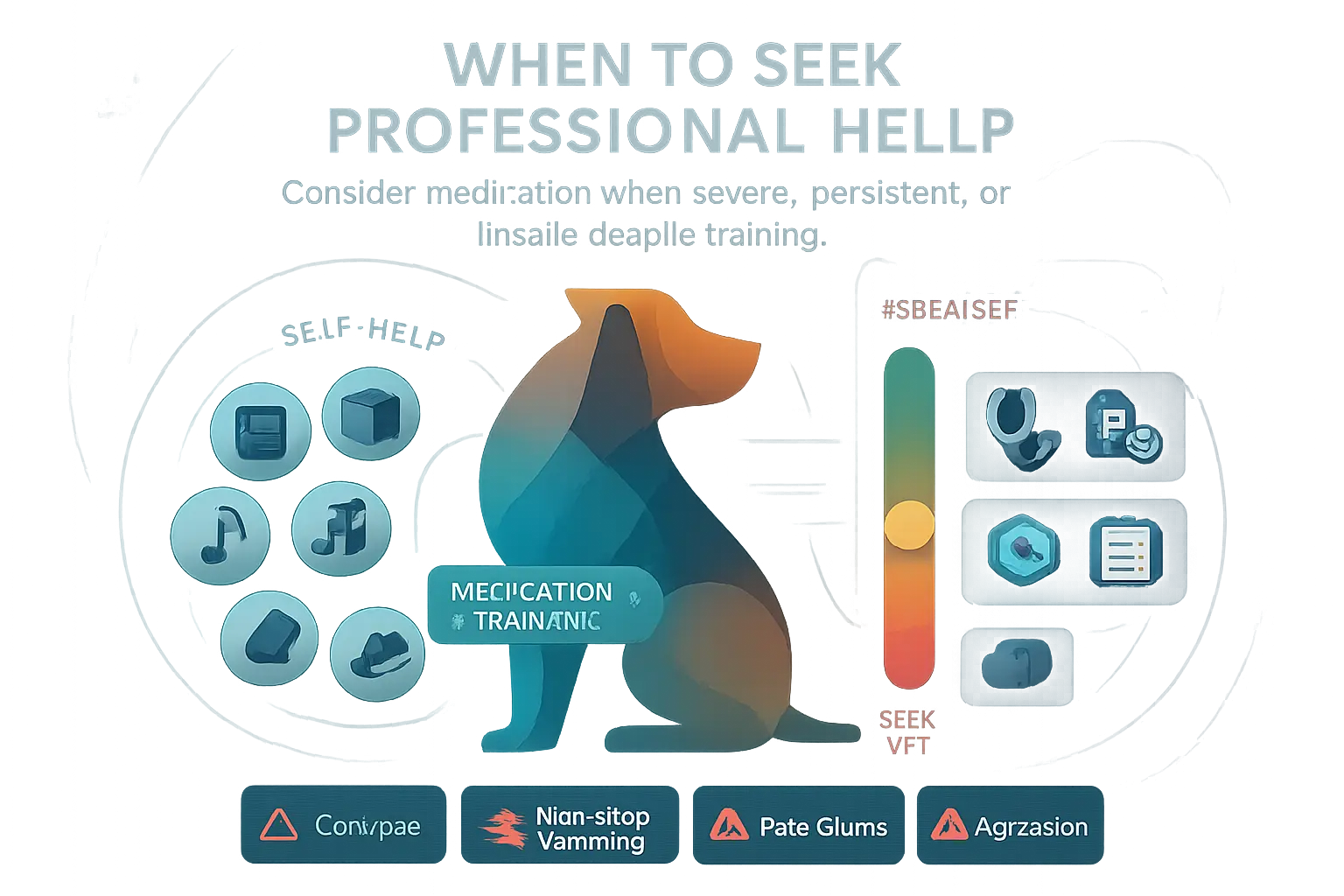
Natural coping strategies suit many dogs, but some animals need professional care. Seek help when anxiety causes harm, prevents travel, or remains unchanged after consistent training. A veterinary exam can rule out medical causes such as vestibular disease or pain. If a dog shows intense panic, repeated vomiting, or escalates to aggression, consult a veterinarian promptly.
Keep a concise log of episodes, triggers, duration, and any physical symptoms. Those notes help clinicians decide whether behavior modification, medication, or both will best protect the dog’s welfare. A timely referral can shorten recovery and improve travel safety.
Signs behavior modification or drugs may be necessary
Look for frequent, severe signs that training alone hasn’t reduced. Red flags include continuous trembling, uncontrolled salivation or vomiting, frantic escape attempts, destructive behavior, and sudden aggression. Also note anticipatory anxiety—intense distress before a trip begins. If the dog cannot learn calm responses after several weeks of structured desensitization, medication may be required to lower arousal and enable learning. Share video or written records with the veterinarian to illustrate severity.
What a veterinary behaviorist or trainer can offer
A veterinary behaviorist performs a medical and behavioral assessment, diagnoses anxiety disorders, and prescribes medication when appropriate. They design graduated desensitization and counterconditioning plans customized to the dog’s history and sensitivity. Certified trainers translate those plans into practical, repeatable exercises owners can use during trips. For guidance on practical travel-focused training, see make car rides enjoyable for motion‑sick pups, which covers conditioning steps and equipment choices helpful alongside behavior work.
Safe ways to combine natural strategies with prescribed treatments
When medication enters the plan, integrate it with behavior modification rather than replacing training. Use short-term pharmacologic support to reduce panic while teaching new, relaxed responses. Continue pheromone therapy, calming vests, structured desensitization, and enrichment during treatment. Monitor for side effects and schedule follow-ups to taper drugs once progress stabilizes. Never change doses or stop medication without veterinary guidance. Owners should keep training consistent and reward calm behavior to make the combined approach effective. For immediate action, request a veterinary or behaviorist consultation if the dog’s travel anxiety meets the red-flag criteria above.
Summary
9 Natural Ways to Remedy Your Dog’s Travel Anxiety: Vet‑Approved, Practical Tips gives owners a clear, step-by-step path to identify the root of travel stress, prepare safely, and use evidence‑informed, natural methods to help dogs stay calm on the road, rail, or in the air. It explains how to differentiate motion sickness, fear, and noise sensitivity; when signs signal an emergency; and how to build a predictable, soothing travel setup that combines secure restraint, familiar scents, sound management, and visual control.
The post outlines nine natural strategies—gradual desensitization, a comforting travel zone, gentle pressure, pheromones, calming audio, pre‑trip exercise, vet‑approved supplements, calming touch, and food‑based enrichment—plus a structured training plan, smart pre‑trip logistics, and responsible supplement use. It closes with guidance on when to seek professional help and how to integrate medication with behavior work for dogs whose anxiety remains severe.
Key Takeaways
- Confirm the cause first: Use timing and signs to distinguish motion sickness from fear or noise sensitivity; keep video logs and consult a veterinarian when in doubt.
- Set up a calming, safe space: Use a secured crate or crash‑tested harness, stable bedding with familiar scents, steady airflow, low‑volume calming music, and controlled sightlines.
- Practice makes progress: Run daily, short desensitization drives; pair travel cues with high‑value rewards; end sessions before stress escalates; track progress and adjust pacing.
- Layer natural tools: Gentle pressure garments, pheromone sprays/collars, pre‑trip exercise, massage with predictable cues, and chew/puzzle enrichment can reduce arousal during trips.
- Use supplements responsibly: Options like L‑theanine, melatonin, chamomile, CBD, and Rescue Remedy may help; trial one at a time at home and follow veterinary guidance on dosing and interactions.
- Plan the logistics: Schedule a vet check, time meals/water/meds, map breaks every 1–2 hours, and carry ID, records, a first‑aid kit, and emergency contacts.
FAQ
- What is the quickest natural way to calm a dog before a trip? Combine a well‑timed exercise session, a properly fitted pressure wrap, pheromone support, and a long‑lasting chew with low‑volume calming music. This layered approach offers immediate relief while longer‑term training builds resilience.
- How can owners tell motion sickness from anxiety? Motion sickness appears early with drooling, lip‑smacking, yawning, nausea, and vomiting; fear shows hypervigilance, trembling, and escape attempts; noise sensitivity triggers startle and freezing only with specific sounds. Short, controlled tests help separate these causes.
- What natural supplements are commonly used and how should they be introduced? L‑theanine, melatonin, chamomile, CBD, and Rescue Remedy are common options. Introduce one at a time at home, start at the lowest labeled dose, monitor for 24–72 hours, and consult a veterinarian to avoid interactions.
- How often should practice rides happen and how long should they last? Aim for daily micro‑sessions of 5–10 minutes, ending before stress appears. Gradually increase by 2–5 minutes as calm behavior becomes consistent.
- Why do crate covers or forward‑facing setups help anxious travelers? Reducing visual motion lowers arousal and may decrease nausea; facing forward and partially covering side views creates a den‑like feel that helps many dogs settle.

